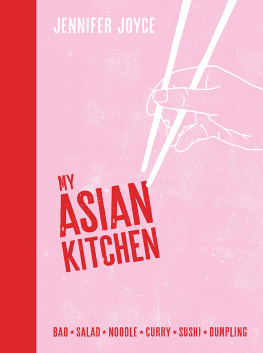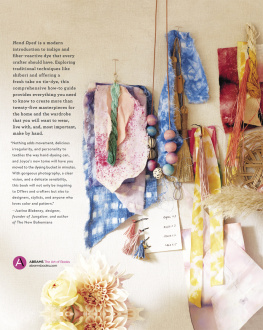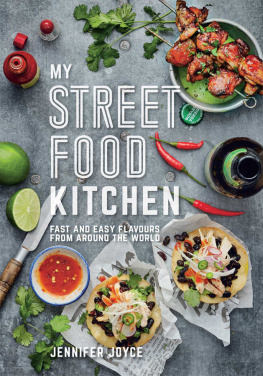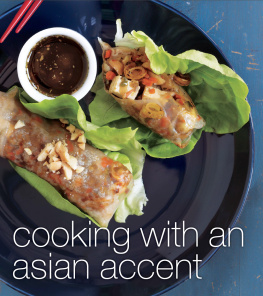Bao buns, pho, sushi, poke bowls, gyoza, ramen and kimchi have devotees on every high street now Jennifer Joyce shows how easy it is to create these zingy, fresh, healthy flavours at home. From grilled sticky skewers and steak tacos, salads, rice bowls and dumplings, to prawn katsu bao and miso-glazed ribs, this is an adventure in the dazzling diversity of modern Asian cooking. Jennifer's exquisitely simple recipes, no-nonsense explanation of ingredients, hand-drawn diagrams and beautiful photographs are all you need to start cooking in your very own Asian Kitchen.
WELCOME TO THE ASIAN CLASSICS, OLD AND NEW Growing up in the United States, my childhood Asian food experiences were, sadly, limited to Americanised Chinese (AKA chop suey and egg rolls). It wasnt until I began travelling to Asia in the early 1990s that I discovered the staggering deliciousness of authentic Asian cooking. In this new world I became acquainted with all-stars like khao soi gai, karaage fried chicken, pho, potsticker dumplings and ramen.
It wasnt just the hot-salty-sour punch I fell for, but the multitude of textures. From blistering curries to pillow soft bao, I was spoilt for choice at every meal. I went back again and again. After each trip I aspired to conquer my favourite dishes, balancing flavours and learning new techniques. My Asian Kitchen is the result of many years of experiments and tasty discoveries. Successfully cooking this legendary cuisine isnt magic: you just need solid guidance and the right ingredients.
Asian food is loved and sought after for its mouthwatering tastes, but it also has the added perk of real health benefits. Miso, soy, bean paste, black vinegar, fish sauce and gochujang are all produced from the fermentation of rice, anchovies or soya beans. These key components intensify the flavour of Asian dishes, while also strengthening our immune and digestive systems. Their punchiness encapsulates what umami is all about this powerful savoury fifth element (alongside sweet, sour, salty and bitter) is responsible for the oohs, aahs and smiles as we devour our favourite dishes. Fermentation and umami lie at the heart of Asian cooking and they are the reasons for its addictive irresistibility. Not that long ago eastern-style cooking was alien to many western cooks and frustrating to master because the ingredients were extremely hard to source.
But in recent decades, international travel, a huge increase in the number of Asian restaurants and the advent of social media have educated and encouraged more adventurous home cooks. This in turn has lead to the widespread availability of products and ingredients such as yuzu juice, Sichuan peppercorns, tamarind pure and Thai chilli paste through online services and Asian superstores. To successfully replicate an authentic dish, there is usually going to be one critical flavour that is essential whether that is togarashi, mirin or chilli bean paste. With the key items now just one click away, restaurant-quality food can be cooked up easily and enjoyably in your own kitchen. My Asian Kitchen celebrates the classics you know and love, shows you the undiscovered and includes new modern recipes, such as healthy salads and Asian-inspired desserts. Instead of grouping recipes by country, Ive arranged them by style of dish.
If its a spicy stir-fry youre after, check out the . Recipes are simplified, with short cuts where appropriate, but not at the expense of sacrificing flavour. Ive included drawings and guides throughout the book to help you tackle difficult tasks such as folding your own dumplings, achieving the perfect grill technique or personalising your ramen and donabe hot pots. The recipes are supplemented by a comprehensive , which explains the uniqueness of Asian ingredients, how they differ between countries and brands and what to look for when buying. My Asian Kitchen aims to equip you with the cooking knowledge you need to push your understanding of flavours and master your favourite dishes at home. And since Asian food is all about sharing and socialising, your friends and family are going to be pretty happy and well fed too!
PRAWN AND SWEET ONION TEMPURA Tempura sounds straightforward, but getting the batter right can be tricky.
After many so-so results, I have finally come up with a failproof recipe. A mix of regular and fine flours, such as cornflour, blended with ice-cold soda water creates a blistering coating. The batter should never be thick it only needs to lightly coat the vegetables or prawns, which should be sizzled to a pale colour, not browned. SERVES 4 PREP 10 MINUTES COOK 10 MINUTES 3 sweet onions 250 ml (8 fl oz) ice-cold soda water 1 egg 90 g (3 oz) cornflour 90 g (3 oz) plain flour, plus extra for dredging vegetable oil, for frying 8 very large raw peeled prawns with tails, deveined LIME PONZU SAUCE 45 ml (1 fl oz) Japanese light soy sauce 2 tbsp lime juice 1 tbsp caster sugar Peel the onions, keeping the roots intact. Slice them about 1 cm ( inch) thick and try to keep in one piece. Mix the lime ponzu sauce ingredients together in a small bowl and set aside.
In a large mixing bowl, mix the soda water and egg. Place the flours in another bowl. Scatter some extra plain flour onto a shallow plate and set aside. Heat the oil in a wok or deep medium saucepan until it reaches 180190C (350375F) or when a small piece of bread instantly sizzles. I like to use a sugar thermometer to guarantee a steady temperature. If the oil is too hot, the tempura will burn and if its too low, it will become greasy.
While the oil is heating, make the batter. Pour the dry ingredients into the wet and stir with chopsticks. Stir just enough so that it combines, but is still shaggy and lumpy. Dust the prawns and onions with the extra flour and then dip into the batter. Fry about six or seven pieces at a time and cook until golden, about 34 minutes. Drain on a baking tray topped with a rack.
The rack maintains their crisp finish (versus paper towels, which make them soggy). Serve the tempura immediately with the lime ponzu sauce. NOTE Sweet onions work best here look for varieties such as Vidalia, Maui or Walla Walla.
























